Books are an excellent tool to connect kids with the natural world around them, be it birds in their back yard or the incredible plants in the Amazon rainforest. Whether you’re introducing a child to environmentalism or fostering an existing love of nature and conservation, these 9 non-fiction books are great options for educating and empowering children to care about our planet.
1. Water: Protect Freshwater to Save Life on Earth by Catherine Barr (author), Christiane Engel (illustrator). Ages 6+.
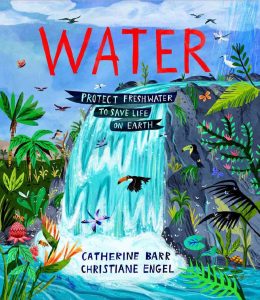 This beautifully illustrated hardcover children’s book shares a positive message about the importance of clean freshwater. Water opens by explaining how the water cycle works, the different types of water on Earth, and what animals depend on freshwater for their survival. In kid-friendly language, the book then goes into the effects of climate change on freshwater, the problems with water pollution, and how shortages of clean water affect children’s lives worldwide. Barr maintains a positive, hopeful tone as she encourages young readers to use water wisely and protect freshwater to keep our planet healthy.
This beautifully illustrated hardcover children’s book shares a positive message about the importance of clean freshwater. Water opens by explaining how the water cycle works, the different types of water on Earth, and what animals depend on freshwater for their survival. In kid-friendly language, the book then goes into the effects of climate change on freshwater, the problems with water pollution, and how shortages of clean water affect children’s lives worldwide. Barr maintains a positive, hopeful tone as she encourages young readers to use water wisely and protect freshwater to keep our planet healthy.
2. The Rainforest Book written and illustrated by Charlotte Milner. Ages 5-9.
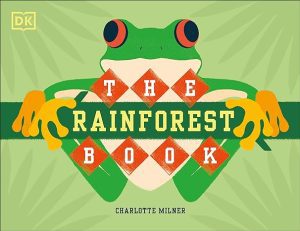 Did you know that over half of Earth’s wildlife live in the rainforest? In The Rainforest Book, Charlotte Milner brings a rainforest encyclopedia to life with captivating illustrations of some of the amazing creatures and plants that call the rainforest home. Elementary readers will discover why the Amazon rainforest is known as the “lungs” of our Earth and learn about the impacts of deforestation and climate change. There is also a gardening activity section on growing your own miniature rainforest at home. This book is one of a larger, highly-recommended series called Conservation for Kids.
Did you know that over half of Earth’s wildlife live in the rainforest? In The Rainforest Book, Charlotte Milner brings a rainforest encyclopedia to life with captivating illustrations of some of the amazing creatures and plants that call the rainforest home. Elementary readers will discover why the Amazon rainforest is known as the “lungs” of our Earth and learn about the impacts of deforestation and climate change. There is also a gardening activity section on growing your own miniature rainforest at home. This book is one of a larger, highly-recommended series called Conservation for Kids.
3. What a Waste: Trash, Recycling, and Protecting our Planet by Jess French. Ages 4-11.
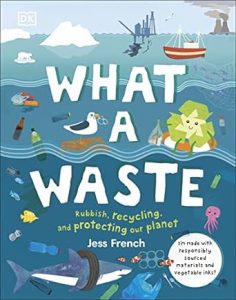
Written by Jess French, a conservationist and veterinarian, this informative book on waste teaches kids everything they need to know about pollution, litter, and recycling. Designed to teach budding ecologists about our impact on the planet, the book acknowledges where things are going wrong, but it also includes where things are going right and how each reader can become a “planet-defending hero” in small but important ways.
4. Humpback Whale (Young Zoologist Series): A First Field Guide to the Singing Giant of the Ocean by Dr. Asha de Vos (author) and Jialei Sun (illustrator). Ages 5-8.
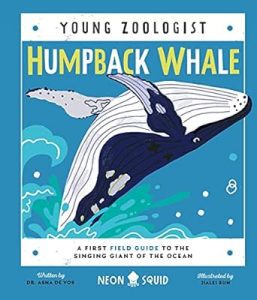 From hunting with bubble nets to their beautiful songs, the Young Zoologist kid’s book Humpback Whale is jam-packed full of fascinating whale facts brought to life with exciting illustrations. The author, Dr. Asha de Vos, is a marine biologist who has dedicated her life to marine conservation and she offers young readers some simple investigative tools that real-life zoologists use in the field. This book also touches on how humpback whales became an endangered species and the conservation efforts that increased their numbers again.
From hunting with bubble nets to their beautiful songs, the Young Zoologist kid’s book Humpback Whale is jam-packed full of fascinating whale facts brought to life with exciting illustrations. The author, Dr. Asha de Vos, is a marine biologist who has dedicated her life to marine conservation and she offers young readers some simple investigative tools that real-life zoologists use in the field. This book also touches on how humpback whales became an endangered species and the conservation efforts that increased their numbers again.
5. Happy Stories for Nature Lovers by Dawn Casey (author) and Domenique Serfontein (illustrator). Ages 5-8.
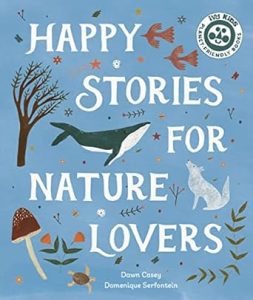 Specifically written with eco-anxious children in mind, this cheerful children’s book offers uplifting tales of conservation success plus age-appropriate tips to manage fear about our environmental futures. Happy Stories for Nature Lovers shows how change is possible and how a pragmatic, collaborative approach can have big impacts. Enhanced by calming and sweet illustrations, this book is both a love letter to nature and a reassuring message to young readers that they can care for the world in a powerful way.
Specifically written with eco-anxious children in mind, this cheerful children’s book offers uplifting tales of conservation success plus age-appropriate tips to manage fear about our environmental futures. Happy Stories for Nature Lovers shows how change is possible and how a pragmatic, collaborative approach can have big impacts. Enhanced by calming and sweet illustrations, this book is both a love letter to nature and a reassuring message to young readers that they can care for the world in a powerful way.
6. Nature’s Best Hope (Young Readers’ Edition): How You Can Save the World in Your Own Yard by Douglas W. Tallamy (author) and Sarah L. Thomson. Ages 11-13.
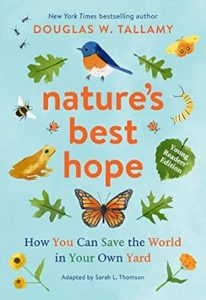 In his New York Times bestseller Nature’s Best Hope, Douglas Tallamy brought attention to devastating impact declining native plant numbers have had on wildlife populations. This middle grade adaption of the book addresses the same issues but in more accessible language. and with black and white photographs. Tallamy’s goal is to introduce readers to a grassroots approach to conservation that they can do from their own backyard. By simplifying complex concepts and offering concrete solutions (like planting asters for bees), Nature’s Best Hope (Young Readers’ Edition) empowers young people to take action for a better future.
In his New York Times bestseller Nature’s Best Hope, Douglas Tallamy brought attention to devastating impact declining native plant numbers have had on wildlife populations. This middle grade adaption of the book addresses the same issues but in more accessible language. and with black and white photographs. Tallamy’s goal is to introduce readers to a grassroots approach to conservation that they can do from their own backyard. By simplifying complex concepts and offering concrete solutions (like planting asters for bees), Nature’s Best Hope (Young Readers’ Edition) empowers young people to take action for a better future.
7. Heroes of the Environment: True Stories of People Who Help Protect Our Planet by Harriet Rohmer (author), Julie McLaughlin (illustrator) and in collaboration with the Natural Resources Defense Council. Ages 9-13.
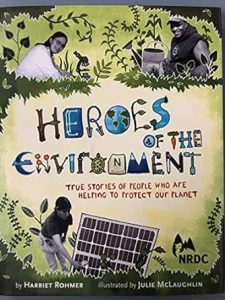 This collection of 12 contemporary environmental heroes of all ages highlights the mantra of “think globally, act locally.” From eleven-year-old Alex Lin’s safe electronic waste disposal campaign in Rhode Island to coal-miner’s daughter Julia Bonds’ work to replace coal with wind power in Appalachia, Heroes of the Environment brings readers inspiring stories of ordinary Northern Americans working to improve their environment and the world at large. Relatively text-heavy and with black-and-white photos, this compilation is ideal for young teens and includes a final chapter with ideas on how they can get involved in their own communities.
This collection of 12 contemporary environmental heroes of all ages highlights the mantra of “think globally, act locally.” From eleven-year-old Alex Lin’s safe electronic waste disposal campaign in Rhode Island to coal-miner’s daughter Julia Bonds’ work to replace coal with wind power in Appalachia, Heroes of the Environment brings readers inspiring stories of ordinary Northern Americans working to improve their environment and the world at large. Relatively text-heavy and with black-and-white photos, this compilation is ideal for young teens and includes a final chapter with ideas on how they can get involved in their own communities.
8. Old Enough to Save the Planet by Loll Kirby (author) and Adelina Lirius (illustrator). Ages 6-12.
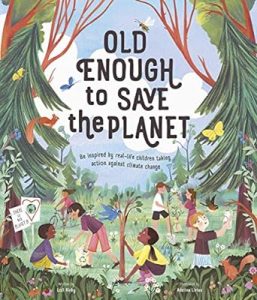 A similar premise to Heroes of the Environment but geared towards younger readers, this picture book spotlights 12 young activists from around the world and explains their impact. Each story in Old Enough to Save the Planet opens with an inspirational line, like nine-year-old German reforestation activist Felix Finkbeiner’s “I’m big enough to save our trees…” to twelve-year-old Ukrainian composter Nikita Shulga’s “I’m responsible enough to make use of our food waste…” With stunning illustrations and engaging stories, Old Enough to Save the Planet is an inspiring call to action for young readers from their peers worldwide.
A similar premise to Heroes of the Environment but geared towards younger readers, this picture book spotlights 12 young activists from around the world and explains their impact. Each story in Old Enough to Save the Planet opens with an inspirational line, like nine-year-old German reforestation activist Felix Finkbeiner’s “I’m big enough to save our trees…” to twelve-year-old Ukrainian composter Nikita Shulga’s “I’m responsible enough to make use of our food waste…” With stunning illustrations and engaging stories, Old Enough to Save the Planet is an inspiring call to action for young readers from their peers worldwide.
9. Rewilding: Bringing Wildlife Back Where It Belongs by David A. Steen (author) and Chiara Fedele (illustrator). Ages 8-10.
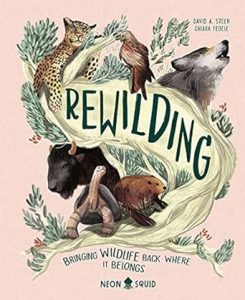 Conservation biologist Dr. David Steen introduces upper elementary readers to the concept of rewilding (returning plants and animals to their natural environment) through inspiring stories of conservation scientists saving wildlife from the brink of extinction. A look into the complex nature of ecosystems and the scientists working to maintain their balance, Rewilding covers efforts like returning wolves to Yellowstone and giant tortoises to the Galápagos, all through stunning illustrations and kid-friendly language.
Conservation biologist Dr. David Steen introduces upper elementary readers to the concept of rewilding (returning plants and animals to their natural environment) through inspiring stories of conservation scientists saving wildlife from the brink of extinction. A look into the complex nature of ecosystems and the scientists working to maintain their balance, Rewilding covers efforts like returning wolves to Yellowstone and giant tortoises to the Galápagos, all through stunning illustrations and kid-friendly language.


